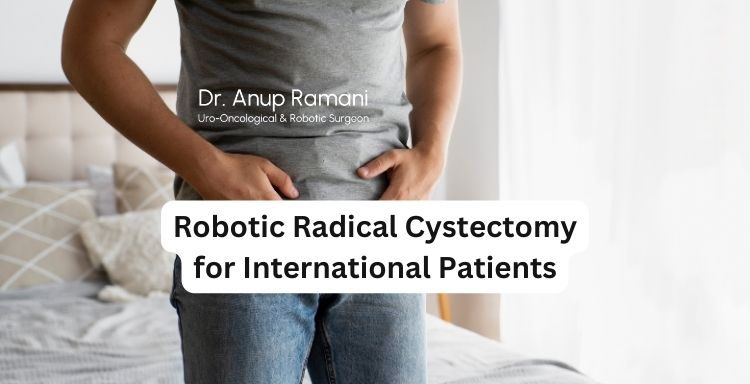Dr Anup Ramani @ Copyright 2024
By Dr. Anup Ramani
Bladder cancer is a life-altering condition, and one of the most advanced treatments available today is Robotic Radical Cystectomy. This minimal invasive procedure is used to remove the bladder and surrounding tissues affected by cancer, offering better precision, reduced recovery time, and fewer complications compared to traditional surgeries. For international patients seeking affordable yet world-class care, medical tourism in India is fast becoming a top choice.
In this article, we’ll explore why international patients are choosing India for Bladder Cancer Treatment, the benefits of Robotic Radical Cystectomy, and why Mumbai and other Indian cities are leading in medical tourism for cancer care.
Understanding Bladder Cancer and Treatment Options
Bladder cancer begins in the cells of the bladder and can spread to other parts of the body if left untreated. Treatment typically involves a combination of surgery, chemotherapy, radiation, and in advanced cases, the complete removal of the bladder through a procedure called Radical Cystectomy.
While Bladder Cancer Surgery has traditionally been performed as open surgery, advances in medical technology now allow for Robotic Radical Cystectomy, a minimal invasive technique that offers several benefits for patients.
What is Robotic Radical Cystectomy?
Robotic Radical Cystectomy is a minimal invasive surgery where the surgeon uses a robotic system to remove the bladder and, in some cases, nearby organs that may also be affected by cancer, such as the prostate in men or part of the reproductive system in women. This method is highly precise, using small incisions that lead to less pain and faster recovery.
This technique is now widely available across India, with cities like Mumbai being at the forefront of offering Robotic Radical Cystectomy in India.
Advantages of Robotic Radical Cystectomy
Opting for Robotic Surgery for Bladder Removal offers several key advantages over traditional open surgery:
- Precision and Accuracy: The robotic system provides surgeons with enhanced control and precision, minimizing damage to surrounding tissues.
- Minimal Scarring: Smaller incisions lead to less visible scarring and quicker healing.
- Reduced Blood Loss: Patients experience less blood loss during the surgery due to the minimal invasive nature of the procedure.
- Faster Recovery Time: Patients undergoing Minimal Invasive Radical Cystectomy typically have a shorter hospital stay and a faster return to normal activities.
- Lower Risk of Complications: Fewer complications like infections or postoperative pain are reported with robotic surgery.
These benefits make Robotic Radical Cystectomy an ideal choice for international patients looking for effective, minimal invasive bladder cancer treatment.
Why Choose India for Robotic Radical Cystectomy?
1. World-Class Medical Facilities
India is home to some of the most advanced medical facilities in the world, especially for cancer treatment. Top hospitals in Mumbai, Delhi, and other major cities offer state-of-the-art robotic surgical systems, making Robotic Radical Cystectomy in India a widely available option for patients. Hospitals are equipped with the latest technology and staffed by highly experienced medical teams, ensuring international patients receive high-quality care.
2. Experienced Bladder Cancer Surgeons
India is known for having some of the world’s best surgeons specializing in Bladder Cancer Surgery. These surgeons have extensive training and experience in performing Robotic Radical Cystectomy, making them highly sought after by both local and international patients. Surgeons in Mumbai and other Indian cities frequently perform complex cancer surgeries, making them well-versed in handling various stages of bladder cancer.
If you’re seeking the Best Urinary Bladder Cancer Surgeon, India offers a wide selection of top-tier professionals with specialized skills in robotic surgery. Surgeons in Mumbai are particularly known for their expertise in Robotic Radical Cystectomy.
3. Affordability and Cost Savings
One of the most compelling reasons international patients choose India for Bladder Cancer Treatment is the significant cost savings. Bladder Cancer Surgery in India is far more affordable than in countries like the US, UK, or Australia, while still maintaining high standards of care. The cost of Robotic Radical Cystectomy in India can be up to 60-70% lower than in Western countries, making it an attractive option for patients seeking advanced cancer treatment without the hefty price tag.
Even when factoring in travel and accommodation costs, medical tourism in India remains a cost-effective option for patients from abroad.
4. Comprehensive Medical Tourism Services
India’s medical tourism industry is well-established, offering comprehensive support for international patients. From helping with medical visas and travel arrangements to providing translators and post-treatment care, hospitals in cities like Mumbai ensure that international patients have a seamless and comfortable experience. Many hospitals also provide concierge services that handle all aspects of a patient’s stay, from admission to discharge and follow-up.
5. Shorter Waiting Times
In countries with socialized healthcare systems, patients often face long waiting times for critical surgeries. In contrast, India offers shorter waiting times for international patients seeking Bladder Cancer Surgery. Leading hospitals in Mumbai and other cities prioritize timely treatment, ensuring that patients get the care they need without unnecessary delays.
Robotic Radical Cystectomy in Mumbai: A Leading Destination for Bladder Cancer Surgery
Mumbai, India’s financial and healthcare hub, has emerged as a leading destination for Robotic Radical Cystectomy. The city is home to some of the best hospitals and bladder cancer specialists in the country. Whether it’s the Bladder Cancer Treatment in Mumbai or the expertise of surgeons performing Robotic Radical Cystectomy in Mumbai, international patients are increasingly choosing this city for top-tier healthcare.
Hospitals in Mumbai offer the latest robotic surgical systems, and many of the surgeons are internationally trained, giving patients confidence in the quality of their treatment. Moreover, the costs of Robotic Radical Cystectomy in Mumbai are lower than in many Western countries, making it a highly attractive option for international medical tourists.

Why Medical Tourism in India is Ideal for Bladder Cancer Treatment
1. High Success Rates
India’s success rates for bladder cancer treatments, particularly Robotic Radical Cystectomy, are comparable to those in the most developed countries. This success is largely due to the availability of advanced medical technology, highly skilled surgeons, and comprehensive patient care systems.
2. Access to Cutting-Edge Technology
Hospitals in India use the most advanced technology for bladder cancer surgeries, including Robotic Surgery for Bladder Removal. These robotic systems provide surgeons with greater flexibility and precision, which is crucial in complex surgeries like Robotic Radical Cystectomy.
3. Comprehensive Care Packages for International Patients
India’s medical tourism packages often include everything from pre-surgery consultations and tests to post-surgery recovery and follow-up care. International patients can expect detailed support throughout their medical journey, ensuring a stress-free experience.
Conclusion
For international patients seeking Bladder Cancer Treatment, India offers the perfect combination of advanced medical technology, experienced surgeons, and affordable healthcare. Robotic Radical Cystectomy in India, particularly in cities like Mumbai, provides world-class treatment options at a fraction of the cost found in Western countries. With minimal waiting times, comprehensive patient care, and high success rates, medical tourism in India is an ideal solution for those in need of advanced bladder cancer surgery.
FAQs - Robotic Radical Cystectomy
What is Robotic Radical Cystectomy?
Robotic Radical Cystectomy is a minimal invasive procedure that uses robotic technology to remove the bladder and surrounding cancerous tissues. It offers benefits like less pain, faster recovery, and fewer complications compared to traditional surgery.
Why should I choose India for Bladder Cancer Surgery?
India offers world-class medical facilities, highly experienced surgeons, and affordable treatment options. International patients can benefit from the advanced technology and cost savings that India provides.
How much does Robotic Radical Cystectomy cost in India?
The cost of Robotic Radical Cystectomy in India is significantly lower than in Western countries, with savings of up to 60-70%. The exact cost depends on the hospital and the complexity of the case.
What are the benefits of Robotic Radical Cystectomy over traditional surgery?
Benefits include smaller incisions, reduced blood loss, faster recovery, and a lower risk of complications.
Can international patients get help with travel and accommodation in India?
Yes, most hospitals in India offer medical tourism services that include assistance with visas, travel arrangements, accommodation, and comprehensive patient care throughout the treatment.
About Author

Uro-Oncological & Robotic Surgeon
Dr. Anup Ramani is a robotic uro-oncological surgeon and an internationally recognized expert in robotic surgery for prostate, kidney and urinary bladder cancers. With more than two decades of robotic experience and 2,000+ robotic procedures, he brings unmatched precision and outcomes to complex uro-oncology cases. He is widely published in his field and is known for a personal, transparent approach-often spending over an hour in initial consultations to educate patients on its disease, surgery and recovery. His expertise spans prostate cancer treatment, kidney and bladder cancer surgery, adrenal gland surgery, kidney stone treatment, penile cancer surgery and enlarged prostate management. Dr. Ramani advocates the advantages of robotic surgery-magnified 3D vision, tremor-filtered precision, minimal scarring, lower blood loss and faster recovery-helping patients return to life sooner.
Table of Contents
Recent Blogs
Best Uro-Oncological surgeon
Specialist in India for Robotic Surgery
MCh, DNB, MS, DNB
Dr. Anup Ramani
CONTACT
Uro-Oncologist in India,
Best Robotic Surgeon for Uro Oncology Surgery
1407, One Lodha Place Next to World Towers Senapati Bapat Marg, Worli, Mumbai. 400013.
Dr Anup Ramani @ Copyright 2024 – Website Maintenance, SEO & GEO by Opal Infotech
- Partial penectomy is done in cases where glans and distal penis is involved with carcinoma.
- Partial penectomy is a type of organ-preserving surgery. Preservation of sexual and micturational function depends on the surgical dissection and reconstruction of residual urethra.
- Patients who develop stones in the kidney or ureter, often experience severe pain.
- This condition usually needs a procedure to remove the kidney stones.
- This procedure is called ureteroscopy and is performed very commonly.
- It does not require any cuts and hence it is painless.
- The procedure is performed with an endoscope inserted through the penis under spinal anesthesia.
- The scope is inserted through the penis into the kidney and stones are dissolved with a laser.
- The procedure takes about 40-50 minutes.
- A catheter (urine pipe) is kept after the procedure to drain the bladder. A stent is kept in the kidney at the same time.
- Patient is mobile and walking in the room the same evening.
- Hospital stay is one night and patient is discharged the next day after removal of the catheter.
- Patient has to come back after six weeks to remove the stent in the kidney.
- Patients can resume office a week after surgery and heavy activities like running, weight lifting, a month after the procedure.
- We offer fixed packages for this procedure which can be obtained by calling our helpline +91 9967666060.
- Men with an enlarged prostate, which is a normal ageing changes, often experiencing difficulty passing urine. This condition usually needs a procedure to trim the prostate and relieve the blockage.
- This procedure is called TURP and is performed very commonly.
- It does not require any cuts and hence it is painless.
- The procedure is performed with an endoscope inserted through the penis under spinal anaesthesia.
- The overgrown prostate is dissolved with a laser bloodlessly.
- The procedure takes about 40 minutes.
- A catheter (urine pipe) is kept after the procedure to drain the bladder.
- Patient is mobile and walking in the room the same evening.
- Hospital stay is two nights and patient is discharged with the catheter, which is removed after 4 days.
- Patients can resume office a week after surgery and heavy activities like running, weight lifting, a month after the procedure.
- We offer fixed packages for this procedure which can be obtained by calling our helpline +91 9967666060.
-
Robotic adrenalectomy is a sophisticated, complex surgery and it is very important that an experienced surgeon performs this surgery to avoid major complications.
-
Once the anesthesia is done, and patient positioned, three micro cuts (3mm each) are made in the patient’s abdomen.
-
The arms of the Da Vinci robot are connected to the cuts via ports (tubes).
-
Dr. Ramani then sits in the controlling console to perform the surgery.
-
On an average, a robotic adrenalectomy takes one hour.
-
The surgery is almost completely bloodless and there has never been any need to transfuse blood after surgery.
-
A urine catheter and bag to drain the bladder is inserted during surgery.
-
A tiny drain pipe may be inserted in the surgical side of the abdomen, connected to a bag.
-
Patient is kept nil-by-mouth the day of the surgery, with IV fluids. Sips of water are started the next day and solid food by day three.
-
The drain pipe, if kept, is removed in the room on day 2 after surgery.
-
The catheter is removed on day two after surgery.
-
Total hospital stay for robotic adrenalectomy is 4 nights (including night before surgery).
-
Post discharge, a doctor from the surgical team visits the patient at home/ hotel room once every day.
On the day of discharge, patient is totally self-sufficient. They are able to walk freely without any pain, dress themselves, shower, toilet and they do not need to hire any nurse or help at home. Almost all patients are back to work within 2 weeks of surgery.
Heavy activities like running, weight lifting can be resumed after a month
Follow up after an adrenalectomy is in the form of CT scans, once a year for 5 years.
Local patients usually meet Dr. Ramani after two weeks to discuss report.Outstation patients are counselled on a phone consultation.
- Dr. Ramani is one of the very few surgeons in India who has the expertise to perform a robotic surgery for bladder cancer, which includes removing the urinary bladder and reconstructing a new bladder robotically.
- Robotic radical cystectomy is an extremely sophisticated, complex surgery and it is very important that an experienced surgeon performs this surgery to avoid major complications.
- Once the anaesthesia is done, and patient positioned, six micro cuts (3mm each) are made in the patient’s abdomen.
- The arms of the Da Vinci robot are connected to the cuts via ports (tubes).
- Dr. Ramani then sits in the controlling console to perform the surgery.
- On an average, a robotic radical cystectomy with an ileal conduit takes 3-4 hours.
- The surgery is almost completely bloodless and there has never been any need to transfuse blood after surgery.
- A urine catheter and bag to drain the new bladder is inserted during surgery.
- Two tiny drain pipe in inserted in the surgical side of the abdomen, connected to a bag.
- Patient is kept nil-by-mouth for 4 days after surgery with IV supplementation of patient’s daily requirements of calories, fats, carbohydrates, proteins and electrolytes.
- The drain pipes are removed in the room on day 3-5 after surgery.
- Total hospital stay for radical cystectomy is 8 nights (including night before surgery).
- Post discharge, a doctor from the surgical team visits the patient at home/ hotel room once every day.
- On the day of discharge, patient is totally self-sufficient. They are able to walk freely without any pain, dress themselves, shower, toilet and they do not need to hire any nurse or help at home.
- Almost all patients are back to work within 6 weeks of surgery. Heavy activities like running, weight lifting can be resumed after two months.
Follow up after a radical a cystectomy is in the form of CT scans, once a year for 5 years.
Histopathology report: Local patients usually meet Dr. Ramani after two weeks to discuss report.
Outstation patients are counselled on a phone consult. Depending on the report, patient may or may not need chemotherapy after surgery.
If chemo is needed, patients may choose to get it done with a medical oncologist of their choice or avail the services of one of the four medical oncologists on our team.
- Robotic partial nephrectomy is a sophisticated, complex surgery and it is very important that an experienced surgeon performs this surgery to avoid major complications. Robotic radical (total) nephrectomy is
- relatively easier but still requires significant experience to consistently deliver results.
- Once the anaesthesia is done, and patient positioned, five micro cuts (3mm each) are made in the patient’s abdomen.
- The arms of the Da Vinci robot are connected to the cuts via ports (tubes).
- Dr. Ramani then sits in the controlling console to perform the surgery.
- On an average, a robotic radical nephrectomy takes one hour and a robotic partial nephrectomy takes about an hour and half.
- The surgery is almost completely bloodless and there has never been any need to transfuse blood after surgery.
- A urine catheter and bag to drain the bladder is inserted during surgery.
- A tiny drain pipe in inserted in the surgical side of the abdomen, connected to a bag.
- Patient is kept nil-by-mouth the day of the surgery, with IV fluids. Sips of water are started the next day and solid food by day three.
- The drain pipe is removed in the room on day 3 after surgery. The catheter is removed on day two after surgery.
- Total hospital stay for radical/partial nephrectomy is 4 nights (including night before surgery).
- Post discharge, a doctor from the surgical team visits the patient at home/ hotel room once every day.
- On the day of discharge, patient is totally self- sufficient.
- They are able to walk freely without any pain, dress themselves, shower, toilet and they do not need to hire any nurse or help at home.
- Almost all patients are back to work within 2-3 weeks of surgery.
- Heavy activities like running, weight lifting can be resumed after a month.
- Follow up after a radical/partial Nephrectomy is in the form of CT scans, once a year for 5 years.
- Local patients usually meet Dr. Ramani after two weeks to discuss report.
- Outstation patients are counselled on a phone consultation.





